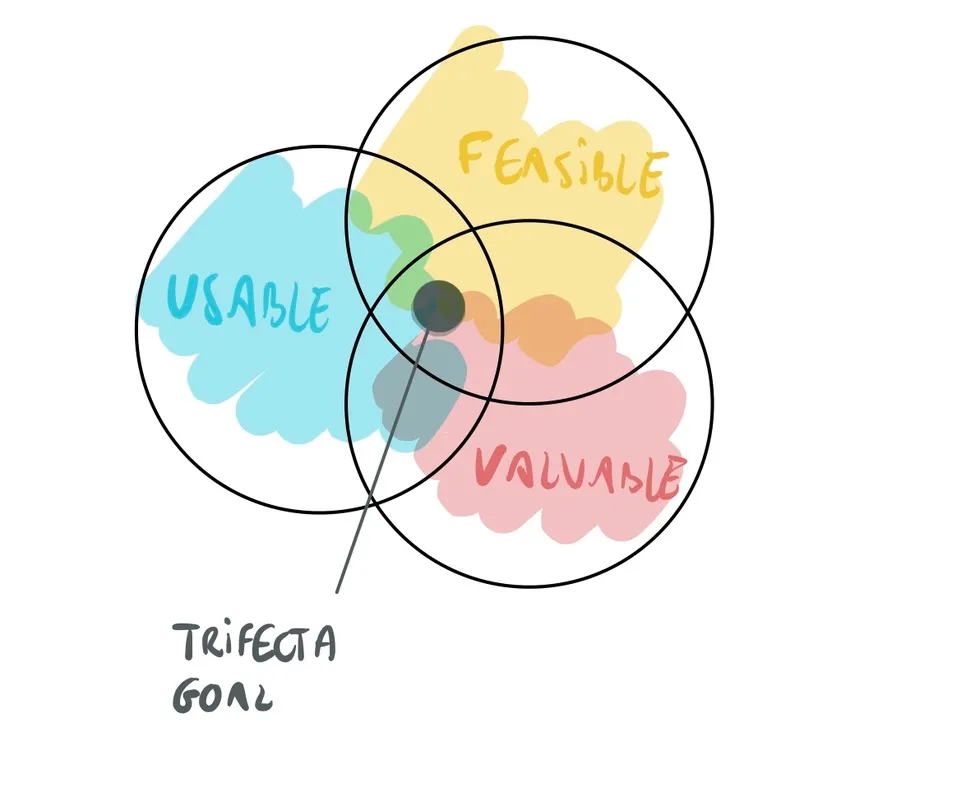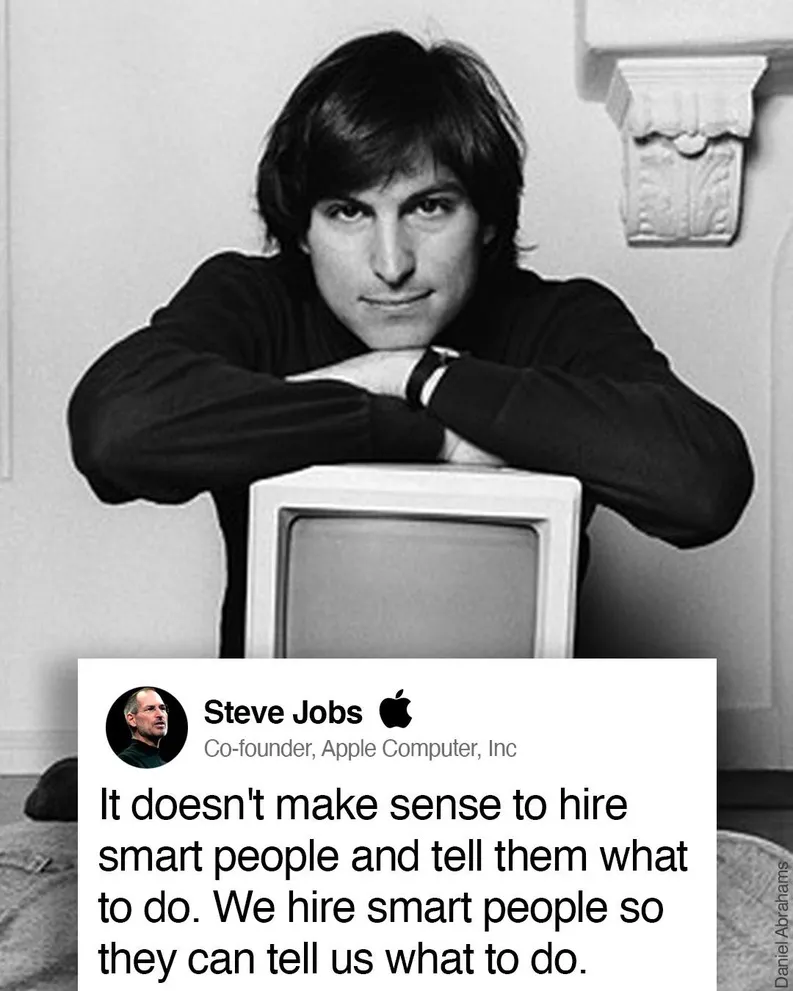Trifecta: How to maximize a product teams impact
Introduction & Definition#
In this blog post, we’ll explore the concept of “trifecta” (also called triad in some organizations) that I have seen used successfully in the past both at start-up and even at large scale organizations (ex: Shopify).
Let’s start with a definition. The trifecta represents a subset of a product team whose goals are to capture systematically:
- value: for the business
- usability: for the user
- feasibility: technological, ethical, legal, etc.
Valuable & Usable & Feasible are the trifecta goal!#
I will use the term craft in this article and would also like to define it: a craft is one or more people inside the product-team with their hierarchy, rituals and specialties. Example of craft includes engineering (sometimes back-end, front-end, mobile), UX (designer, researcher, content specialist, etc.), Product (product manager, product owner, product lead, etc.), data-science (data-scientist, etc.), commercial, legal, etc. Each organization is different and has a different structure to execute its mission. In this article, I will refer to “craft” as the various specialties & hierarchies that exist within the organization.
Most of the time, the trifecta comprises the senior team members of the essential crafts required to build, launch and land your product. Launching a product is easy, but landing it is the hard part ;-)
Depending on the maturity of your organization and team size, it can be a team of 1 (CEO/Founder), 2 (co-founders), 3 (UX, Product, Engineering) or more (commercial, data, partnership, etc.) depending on the problem space the product team is tackling.
The trifecta is an integral part of the product team and a kind of council of the wise that ensures alignment in all day-to-day activities.
Most of the time, a majority of the trifecta members will have authority on some of the product team members as they lead/manage people directly. This statement is often true in the case of UX and engineering. This statement is false for product managers as their leads are not, generally, involved directly in the product team.
Here is an example of a typical “classical” trifecta with three trifecta members and a product team of 11 people.

- Feasibility/Engineering: Staff Developer (leading a team of developers)
- Usability/UX: Senior Designer (leading a team of UX folks)
- Value/Product: Product Manager
- Feasibility/Data: Senior Data-scientist (leading a team of data-scientist)
Note: The “tri” in trifecta does not relate to the number of people in the trifecta (three main crafts: UX, Engineering and Product). It symbolizes that each trifecta member has a responsibility to help the product team make significant decisions quickly so that each of these decisions results in a systematically valuable, feasible and usable product.
Why a trifecta? What problem does it solve?#
1 — Team alignment#
Product teams have the autonomy to decide what to do next and why. They have to convince stakeholders to do so. Why introduce a hierarchy at the team level?

While this is a hierarchy inside the product team, it is crucial to notice that none of the trifecta members has authority on another trifecta member: they are all equals. And they all share the same goal: make sure the product is usable, feasible and valuable. Each brings its area of expertise to the table.
One of the main goals of the trifecta structure is to ensure inter-craft collaboration within the product team. With smart and experienced people, nobody inside the trifecta can understand the totality of the problem space! Because the trifecta members lead other product members, it is a guarantee that everyone on the product team, as well as stakeholders, share this view of the world.
This critical shared view of the world provides the basis for a healthy space where radical candour happens. Each product-team member can ask respectful questions and make sure each decision is considerate of her/his opinions and ideas.
The trifecta does not “lead by committee” to disempower trifecta members. Each craft owns its decisions. For instance:
the product trifecta member makes scope decision the UX trifecta member makes UX decisions, user flow decisions and any design decisions The Eng trifecta member makes implementation decisions, technology decisions, service level objectives’ decisions, etc. Data, Commercial, Go to market, Finance members decide for their craft as well. Once the trifecta sets the decision’s ownership, the other trifecta members may have to disagree and commit. Each trifecta member now supports this decision within their craft: they can use the correct language and arguments to justify the decision within their craft and, if necessary, bring back more information or better proposition that could lead to a decision change.
With a trifecta in place, each trifecta member naturally becomes more considerate and aware of the consequences, risks and impact of every impactful product decision.
The inter-craft team decision can happen within the product team during team rituals (planning sessions, retro, workshops, etc.). It also happens during regular 1:1: Trifecta members have regular 1:1 with their reports. Some also have 1:1 with specific product team members depending on the risk and decision to be made.
The trifecta decision happens during trifecta rituals: most of the time, a weekly meeting where the trifecta assesses progress, reviews the next steps, shares inter-craft news, plans team activities and makes critical decisions.
Trifecta members also tend to have a weekly 1:1 meeting with each other to address any specific issue that could negatively impact the team and the product.
2 — Informal stakeholder alignment#
Thanks to the hierarchy at play in each craft, each trifecta member also has weekly 1:1 within their own craft’s stakeholder. It is also common for trifecta members to have regular 1:1 with stakeholders of other crafts.
All these 1:1 allows feedback to flow continuously back and forth from craft to trifecta and from trifecta to craft regularly. Stakeholders can challenge each decision during these 1:1 and be very naive and candid about it. The most critical feedbacks come from inter-craft 1:1 with stakeholders from one craft and trifecta member from another craft.
Inter-craft decisions are often more ambiguous and more impactful than intra-craft decisions. The discussions between trifecta members and other craft leaders are essential to maintain the right inter-craft balance and ship impactful outcomes.
3 — Formal stakeholder alignment#
During product reviews, the trifecta members are also aligned and have done all the required preparation work with the stakeholders. Usually, stakeholders only want to discuss and align on the most important (and potentially the most conflictual) decisions.
Because each of the trifecta members has a better understanding of other craft’s constraints and requirements, and because lots of informal alignment already occurs (via 1:1 and workshops), all the interested parties are well aware of the problem space and of the context of each decision.
Sometimes one or more stakeholders disagree with the solution. When it happens, the trifecta is mandated to deepen their understanding of the problem, craft, team and organizational constraints. The goal is now for the product team, led by the trifecta, to come back with a better solution.
Stakeholders control the product team resources. In some (less frequent) occasions, stakeholders can reassign the product team to another initiative while only the trifecta continues to work on the problem. These decisions do not signal a lack of trust: these decisions occur to protect the organization. Stakeholders estimate that the trifecta needs to build up the context and develop a better understanding of the problem-space. As a consequence, they keep only the most senior people active so that they have more time to focus on the problem at hand and reassign the team to more concrete and actionable product areas.
4 — External alignment: other product teams & organizations#
The trifecta members also interact within the organization and outside of the organization regarding the product area they are focusing on. It gives them the authority to act as stakeholders for various related-project and to interact within their craft with any team that interacts with the product they are building.
Once again, the fact that each trifecta member as a global understanding of the various decisions, with a focus on the impact created at the crossroads of feasibility, usability and value, gives her/him a lot of context and a lot of ability to influence other teams decisions.
If the product area involves partners outside of the organization, trifecta members are also in an excellent position to interact effectively. They have developed an in-depth knowledge of the context of the product, and they are used to considering the feasibility, usability and value created by the product.
Conclusion#
Trifecta at the product team level plays a vital role in aligning the organization with each of the product decisions. While it introduces a hierarchy in the team, this hierarchy is pre-existing (team leads or seniority) in each craft. Trifecta members create alignment with each other and within the product team as well as with stakeholders in formal (regular lead/report 1:1, rituals) and informal (inter-crafts 1:1, workshops, etc.).
The trifecta is a bit like the heart of a product team. Ideally, stakeholders attribute a problem area to a trifecta at the early stages of the product lifecycle: ideation and exploration. The most experienced team members are assigned to the trifecta. Hard decisions tend to be decided by the trifecta using the existing scheduled meeting, 1:1 and also during an ad-hoc workshop with one or more team members and hands-on stakeholders.
A high-performing trifecta will cause the team to operate at a high-level: hard decisions are debated thoroughly, but the owner will decide without delay. Stakeholders will feel confident that the key aspects of the product (valuable, feasible, usable) are covered and that all crafts (including their own) are aligned.
Trust between the stakeholder and the trifecta causes the product team to be more proactive, more engaged and take more risks. Trust leads to better decisions and more collegial management of risk: the product team will take risks for the most impactful decision with the full commitment of the organization.
High team morale and performance are root causes to ship, launch and land a great product. It starts with a high-performing trifecta.
Feedback is a gift 🙏: Please do not hesitate to share your thoughtsts
- via the contact page form
- via a LinkedIn connexion or message